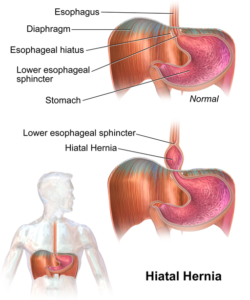Hiatal hernias are one of the biggest obstacles when dealing with GERD and chronic acid reflux.
MEDICAL ILLUSTRATION ABOUT ACID IN STOMACH BACK UP INTO ESOPHAGUS WHICH IS CAUSE GASTROESOPHAGEAL REFLUX DISEASE.
Dietary changes, supplements, herbs, and medications all play a part in treatment.
However, they often do not address the structural problems that could be at the root of chronic acid reflux.
Every patient is different even if they have the same diagnosis. You quickly discover there are many ways to address the different aspects of an illness.
One of the modalities I rely on is Visceral Manipulation, a gentle, hands-on therapy to address the structural restrictions of the organs, fascia, blood vessels, and nerves.
If movement is important for your joints and muscles, it is just as important if not more important for proper organ function. We often forget that our organs, like an ankle or knee, have range of motion simply because it is hidden from view by skin.
If you have been dealing with chronic acid reflux often, often your life can be pretty miserable.
Maybe you have complaints like:
- Constant heartburn that might go all the way up to their throats
- Difficulty swallowing GERD that is triggered by foods including food, coffee, chocolate, mint, spicy food, and even water
- They wonder, “I’ve eliminated everything—dairy, gluten, sugar, and all the typical triggers—what am I going to eat?”
- They have been on PPI’s like omeprazole for years and understand the potentially harmful health effects of chronic PPI use
Conventional GERD management strategies—sleeping elevated, eating smaller meals, avoiding common food triggers, acid blockers and antacids—provide minimal if any relief.
When you have severe GERD, it is the only thing on your mind. You do not know when, how, or where your symptoms will flare.
We know there is often a structural dysfunction of the lower esophageal sphincter and the most common option to deal with this is either watch and wait or surgery.
As a manual therapist and naturopathic physician, I ask myself, “aren’t there less invasive, gentler, and easier ways to deal with this structural issue?”
The structural dysfunctions can be addressed if you understand how and why a sliding hiatal hernia can happen.
What is a hiatal hernia?
A hiatal hernia is a displacement of your stomach from the abdomen (where it should be) and into your chest through the diaphragm (where it should not be).

There are several classifications of hiatal hernias, sliding hiatal hernias and three degrees of paraesophageal hiatal hernias.
Sliding hiatal hernias make up about 95% of hiatal hernias. The problem that occurs with hiatal hernias is a weakening of the lower esophageal sphincter—the muscular ring that prevents stomach acid from reversing direction and going back up into the esophagus.
This acid reflux is what creates the sensation of heartburn. Sliding hiatal hernias are transient—they may slide up and down into and out of the diaphragm.
Although not a medical emergency, this will cause a lot of problems that you may experience as bad acid reflux. Conventional thinking says there is no cure sides watchful waiting or surgery.
Paraesophageal hiatal hernias are a medical emergency, but only make up the minority of cases at about 5%. This occurs when part of the fundus of the stomach is stuck above the diaphragm and can constrict blood flow to the stomach.
Let’s focus on sliding hiatal hernias since they the most common and not well addressed by conventional medications and surgical procedures.
Why do sliding hiatal hernias happen?
The Hiatal Zone
This is the area where the esophagus passes through the diaphragm via the esophageal hiatus and enters the stomach.
There are a few key factors at play that are required for proper hiatal zone health.
Two of the major compartments of the body are the thorax and the abdomen separated by the diaphragm. These as containers have pressure characteristics that keep the two in balance. The thorax has a net negative pressure while the abdomen has a net positive pressure. In a functional state, the pressure in the thorax and the abdomen should balance out. When there is greater pressure in the abdomen than the thorax, it can create the perfect environment for the stomach to herniate through the diaphragm.
The esophageal hiatus is the perfect weak point for the stomach to be pushed upward and create a weakness in the lower esophageal sphincter that contributes to acid reflux.
Some of the factors that increase abdominal pressure:
- Valsalva (e.g. giving birth, bearing down for a bowel movement, coughing)
- Excess abdominal obesity and weight gain
- Sitting for long periods
- Really tight clothing around the waist or chest
- Chronic maldigestion that results in chronic gas and bloating (think food that is poorly digested and is left fermenting in your digestive tract)
How does visceral manipulation treat a sliding hiatal hernia?
The goals of Visceral manipulation treatment:
- Restore the proper position of the stomach and esophagus
- Improve the balance of pressure between the thorax and abdomen
- Improve circulation to the organs for optimal function
- Optimize range of motion and motility of the gastrointestinal tract
- Individualizing treatment based on your unique anatomy
Visceral Manipulation is a gentle first line treatment for sliding hiatal hernias and chronic GERD.



